AMD Frame Pacing Explored: Catalyst 13.8 Brings Consistency to Crossfire
by Ryan Smith on August 1, 2013 2:00 PM ESTHitman: Absolution
The second game in our lineup is Hitman: Absolution. The latest game in Square Enix’s stealth-action series, Hitman: Absolution is a DirectX 11 based title that though a bit heavy on the CPU, can give most GPUs a run for their money. Furthermore it has a built-in benchmark, which gives it a level of standardization that fewer and fewer benchmarks possess.
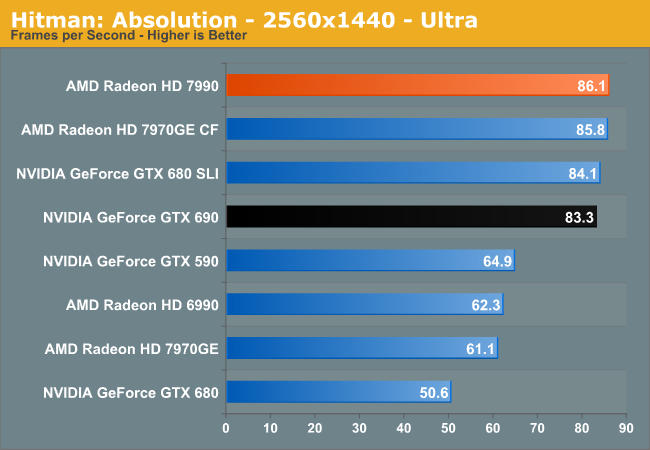
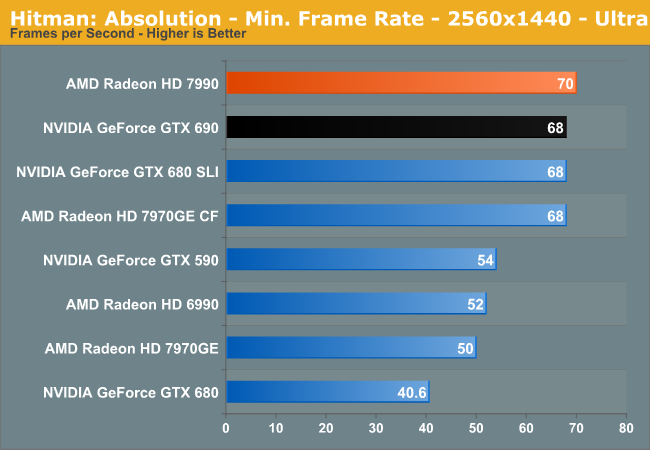
Again there’s nothing really new here. In the previous game the GTX 690 led, while in Hitman the 7990 leads.
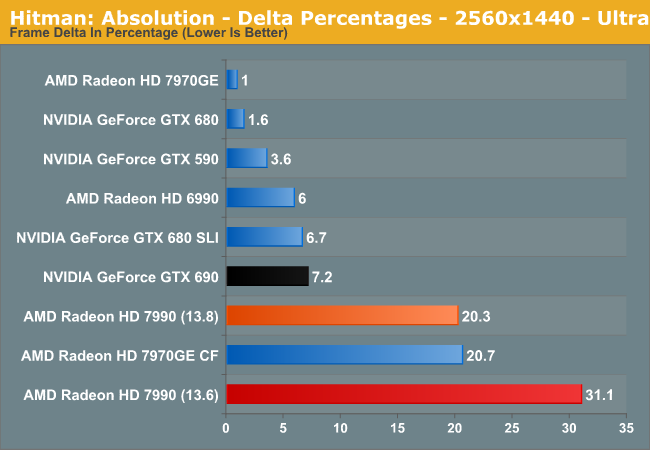
Moving on to our delta percentages, we again see the gains AMD has made with their frame pacing implementation, though Hitman was one of their better games in the first place. Consequently they’ve shaved off 11 percentage points, from 31 to 20, just enough to reach our 20% threshold but no more. This is still 13 percentage points worse than the GTX 690 however, so much like Shogun there’s still clear room for further improvement.
Meanwhile the FCAT graph data shows the same thing we saw with our numerical analysis, with the 7990 showing a much greater degree of variability. AMD’s frame pacing mechanism seems to be much less present here than in other games, with the adaptive window less noticeable here than elsewhere, perhaps due to the relatively high variability.
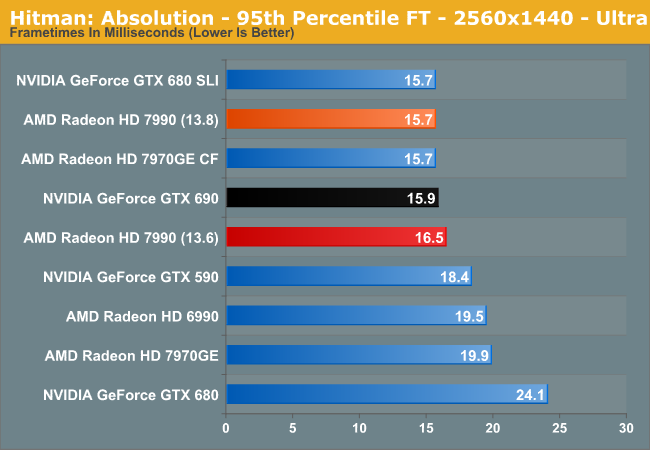
The smaller gains with regards to deltas are reflected in a much smaller improvement on 95th percentile times. Though in this case at the 95th percentile the 7990 is competitive with the GTX 690.


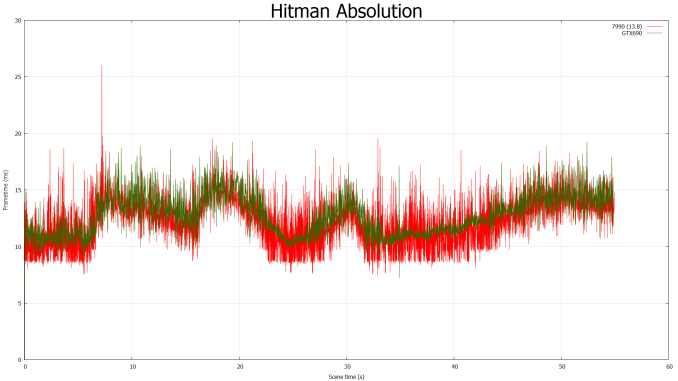








102 Comments
View All Comments
chizow - Friday, August 2, 2013 - link
That makes sense, but I guess the bigger concern from the outset was how AMD's allowance of runtframes/microstutter in an "all out performance" mentality might have overstated their performance. You found in your review that AMD performance typically dropped 5-10% as a result of this fix, that should certainly be considered, especially if AMD isn't doing a good job of making sure they implement this frame time fix across all their drivers, games, APIs etc.Also, any word whether this is a driver-level fix or an game-specific profile optimization (like CF, SLI, AA profiles)?
Ryan Smith - Friday, August 2, 2013 - link
The performance aspect is a bit weird. To be honest I'm not sure why performance was up with Cat 13.6 in the first place. For a mature platform like Tahiti it's unusual.As for the fix, AMD has always presented it as being a driver level fix. Now there are still individual game-level optimizations - AMD is currently trying to do something about Far Cry 3's generally terrible consistency, for example (an act I'm convinced is equivalent to parting the Red Sea) - but the basic frame pacing mechanism is universal.
Thanny - Thursday, August 1, 2013 - link
Perhaps this will be the end of the ludicrous "runt" frame concept.All frames with vsync disabled are runts, since they are never completely displayed. With a sufficiently fast graphics card and/or sufficiently less complex game, every frame will be a runt even by the arbitrary definitions you find at sites like this.
And all the while, nothing at all is ever said about the most hideous artifact of all - screen tearing.
Asik - Thursday, August 1, 2013 - link
There is a simple and definite fix for tearing artifacts and you mention it yourself - vsync. If screen tearing bothers you, and I think it should bother most people, you should keep vsync on at all times.chizow - Thursday, August 1, 2013 - link
Vsync or frame limiters are certainly workarounds, but it also introduces input lag and largely negates the benefit of having multiple powerful GPUs to begin with. A 120Hz monitor would increase the headroom for Vsync, but also by nature reduces the need for Vsync (there's much less tearing).krutou - Friday, August 2, 2013 - link
Triple buffering solves tearing without introducing significant input lag. VSync is essentially triple buffering + frame limiter + timing funny business.I have a feeling that Nvidia's implementation of VSync might actually not have input lag due to their frame metering technology.
Relevant: http://www.anandtech.com/show/2794/3
chizow - Saturday, August 3, 2013 - link
Yes this is certainly true, when I was on 60Hz I would always enable Triple Buffering when available, however, TB isn't the norm and few games implemented it natively. Even fewer implemented it correctly, most use a 3 frame render ahead queue, similar to the Nvidia driver forcing it which is essentially a driver hack for DX.Having said all that, TB does still have some input lag even at 120Hz even with Nvidia Vsync compared to 120Hz without Vsync (my preferred method of gaming now when not using 3D).
vegemeister - Monday, August 5, 2013 - link
The amount of tearing is independent the refresh rate of your monitor. If you have vsync off, every frame rendered creates a tear line. If you are drawing frames at 80Hz without vsync, you are going to see a tear every 1/80 of a second no matter what the refresh rate of your screen is. The only difference is that a 60Hz screen would occasionally have two tear lines on screen at once.chizow - Thursday, August 1, 2013 - link
Sorry, not even remotely close to true. Runt frames were literally tiny shreds of frames followed by full frames, unlike normal screen tearing with Vsync off that results in 1/3 or more of the frame being updated at a time, consistently.The difference is, one method does provide the impression of fluidity and change from one frame to the next (with palpable tearing) whereas runt frames are literally worthless unless you think 3-4 rows worth of image followed by full images provides any meaningful sense of motion.
I do love the term "runt frame" though, an anachronism in the tech world born of AMD's ineptitude with regard to CrossFire. I for one will miss it.
Thanny - Thursday, August 1, 2013 - link
You're not making sense. All frames with vsync off are partial. The frame buffer is replaced in the middle of screen updates, so no rendered frame is ever displayed completely.A sense of motion is achieved by displaying different frames in a time sequence. It has nothing to do with showing parts of different frames in the same screen refresh.
And vsync adds a maximum latency of the inverse of the screen refresh (16.67ms for a 60Hz display). On average, it will be half that. If you have a very laggy monitor (Overdrive-TN, PVA, or MVA panel types), that tiny bump from vsync might push the display lag to noticeability. For plain TN and IPS panels (not to mention CRT), there will be no detectable display lag with vsync on.